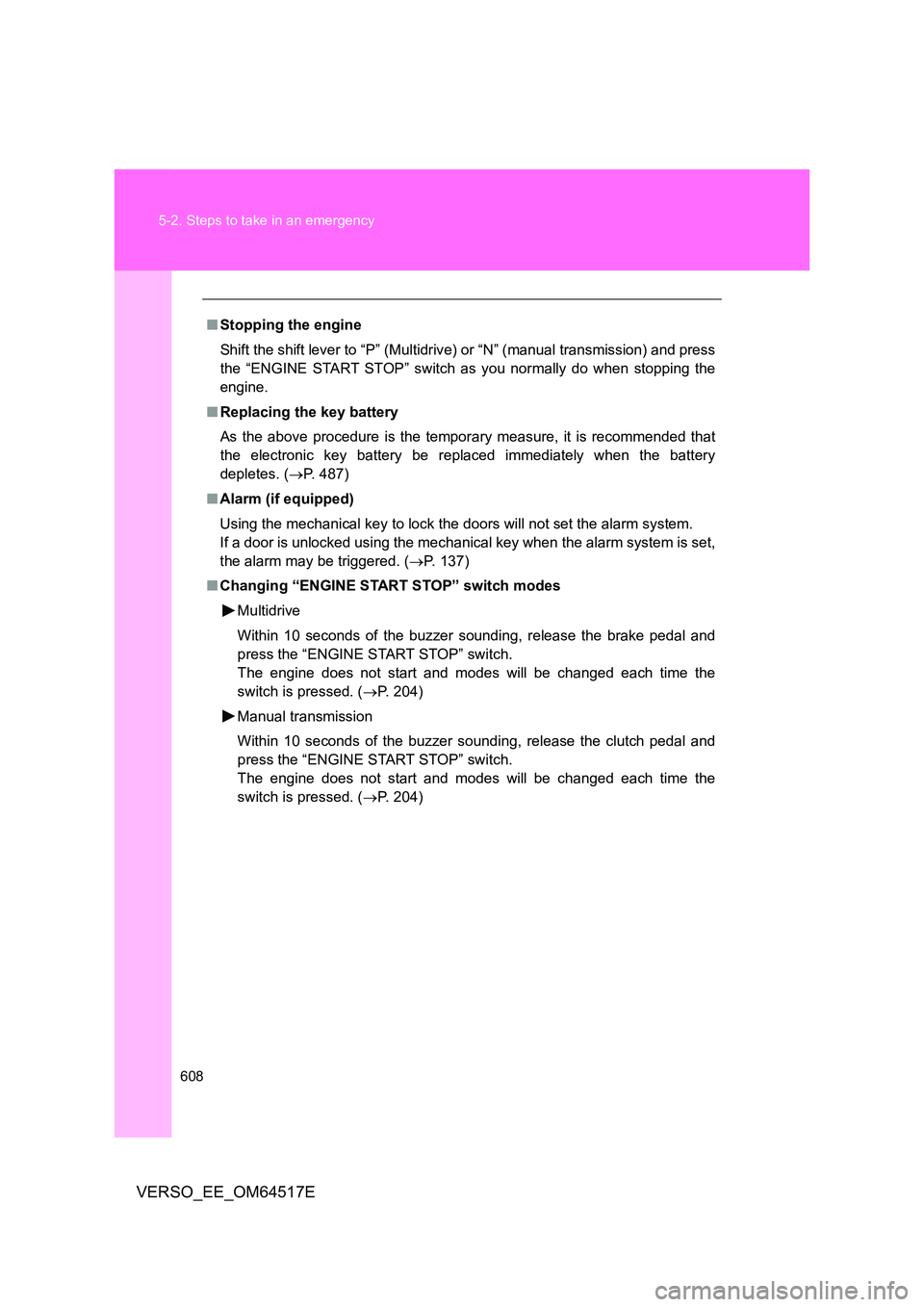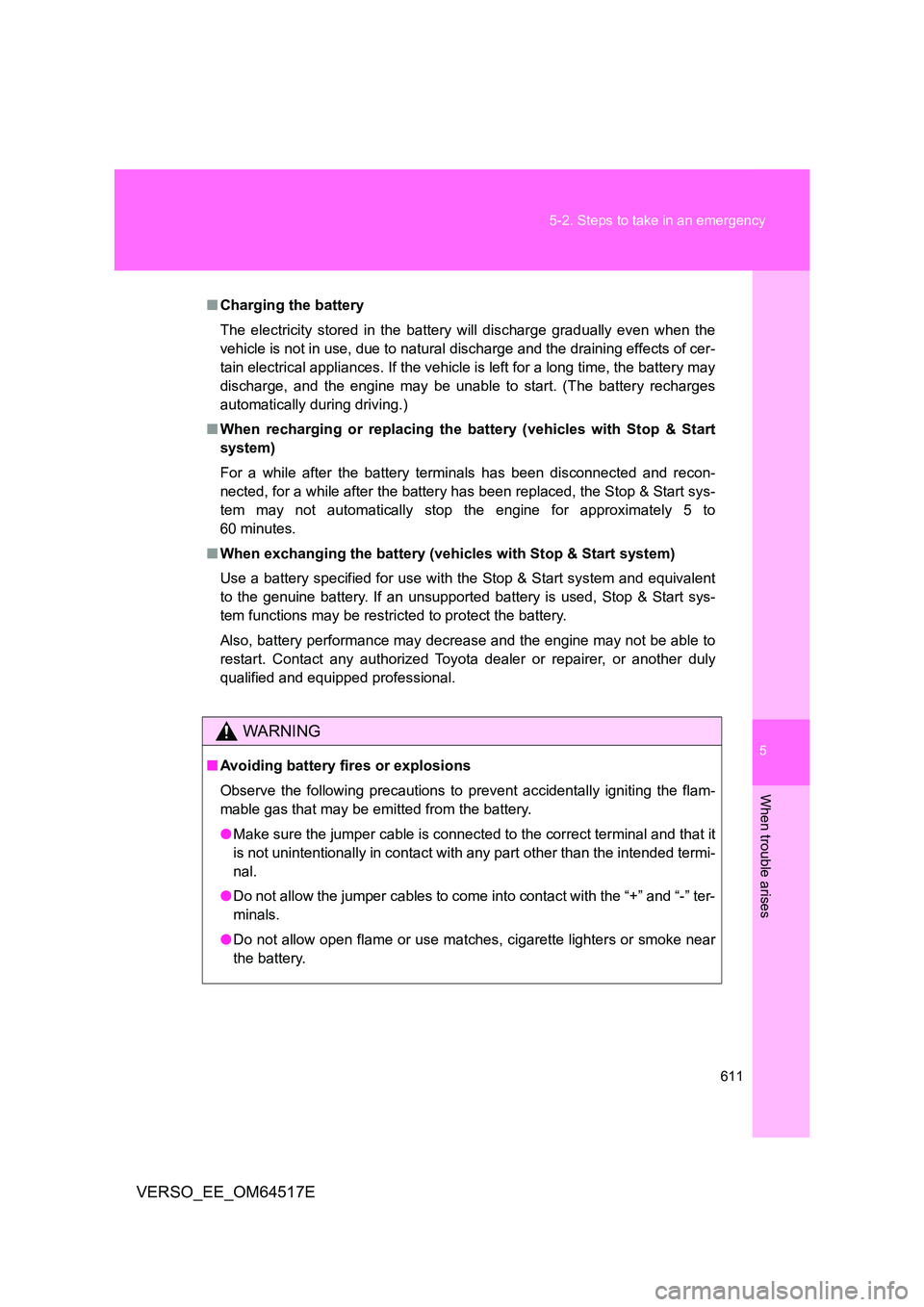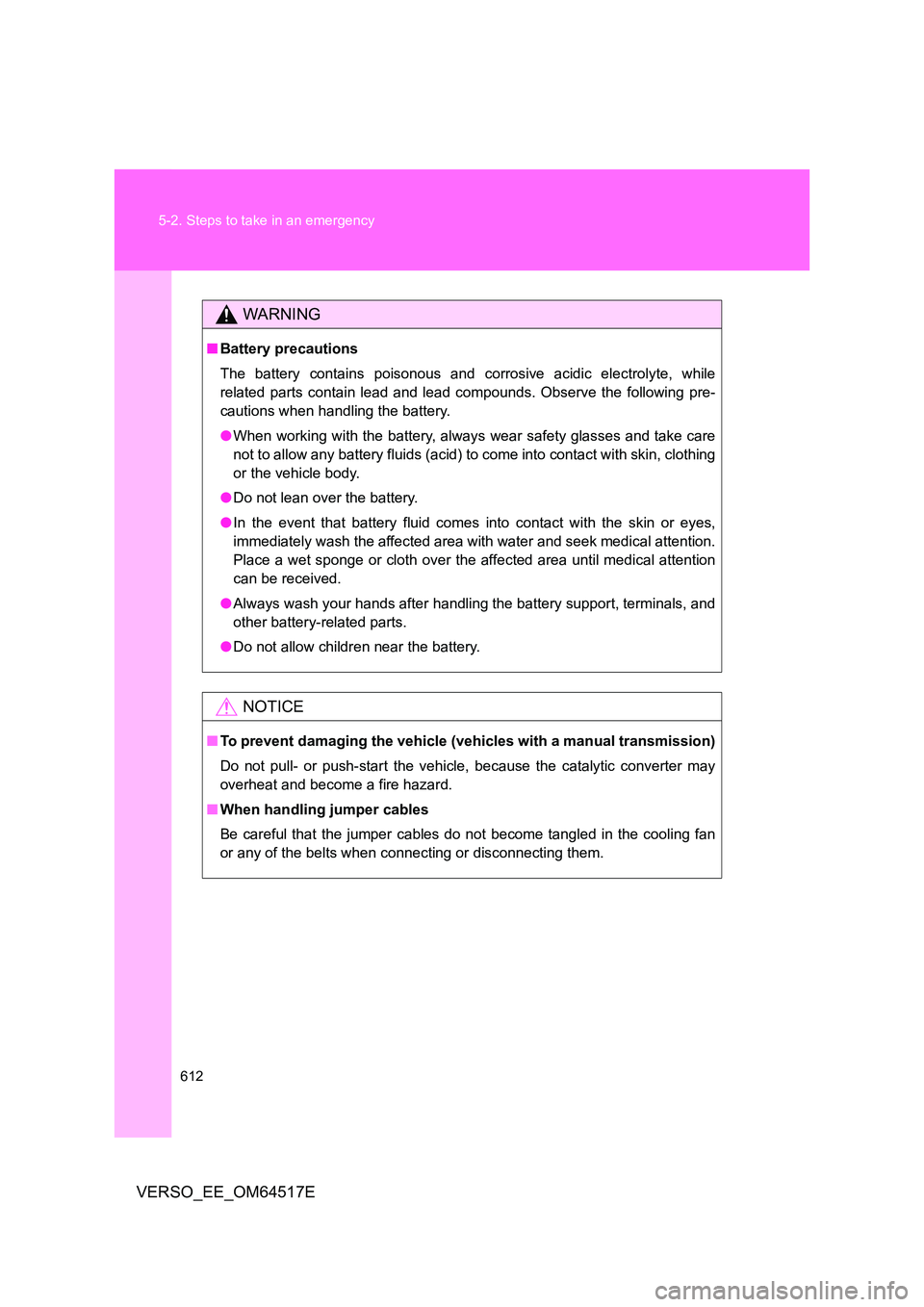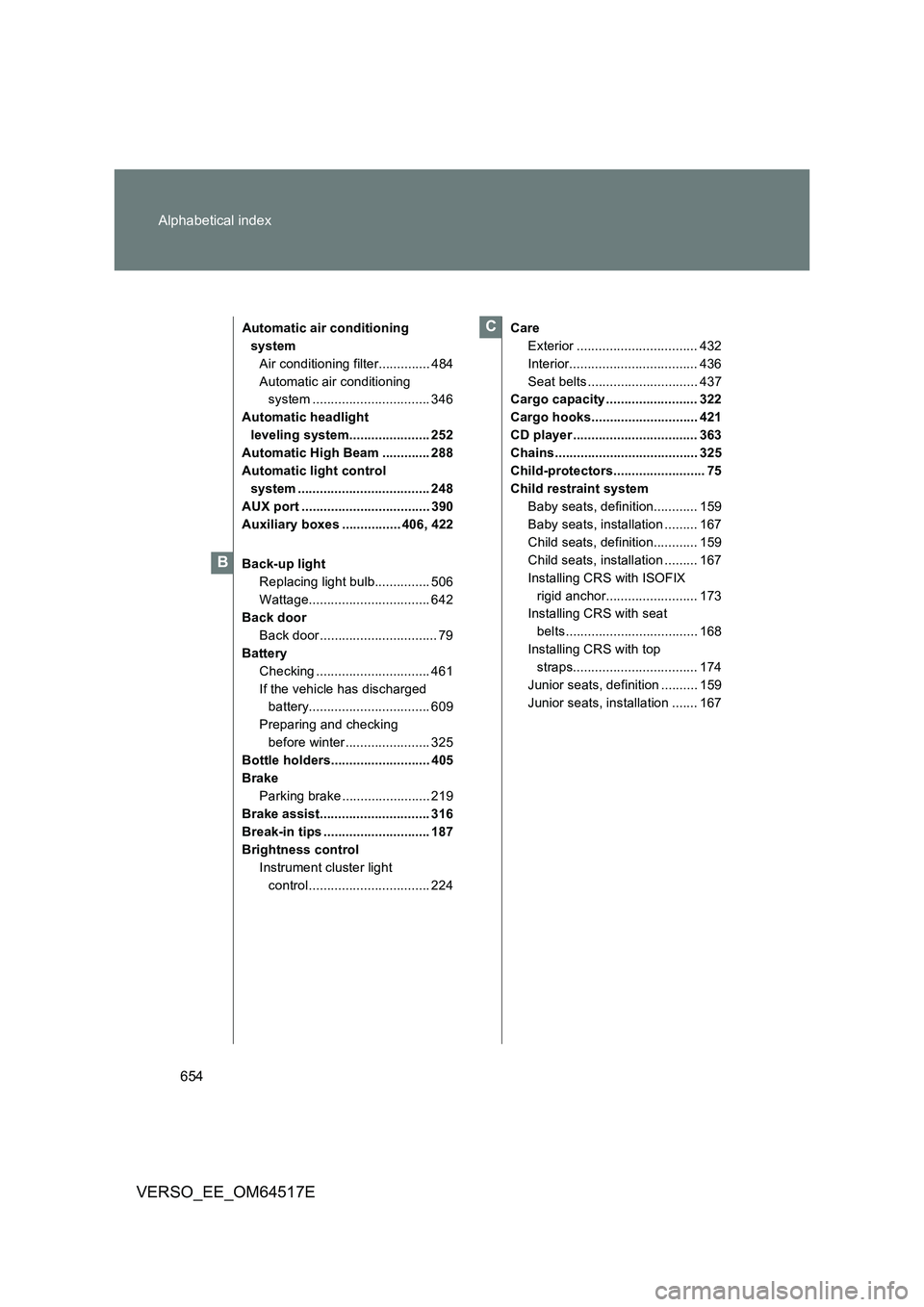Page 608 of 668

608
5-2. Steps to take in an emergency
VERSO_EE_OM64517E
■ Stopping the engine
Shift the shift lever to “P” (Multidriv e) or “N” (manual transmission) and press
the “ENGINE START STOP” switch as you normally do when stopping the
engine.
■ Replacing the key battery
As the above procedure is the temporary measure, it is recommended that
the electronic key battery be replaced immediately when the battery
depletes. ( P. 487)
■ Alarm (if equipped)
Using the mechanical key to lock the doors will not set the alarm system.
If a door is unlocked using the mechanical key when the alarm system is set,
the alarm may be triggered. ( P. 137)
■ Changing “ENGINE START STOP” switch modes
Multidrive
Within 10 seconds of the buzzer sounding, release the brake pedal and
press the “ENGINE START STOP” switch.
The engine does not start and modes will be changed each time the
switch is pressed. ( P. 204)
Manual transmission
Within 10 seconds of the buzzer sounding, release the clutch pedal and
press the “ENGINE START STOP” switch.
The engine does not start and modes will be changed each time the
switch is pressed. ( P. 204)
Page 609 of 668
5
609
5-2. Steps to take in an emergency
When trouble arises
VERSO_EE_OM64517E
If the vehicle battery is discharged
The following procedures may be used to start the engine if the vehi-
cle’s battery is discharged.
You can call any authorized Toyota dealer or repairer, or another duly
qualified and equipped professional.
If you have a set of jumper (or booster) cables and a second vehi-
cle with a 12-volt battery, you can jump start your Toyota following
the steps below.
Vehicles with alarm: Confirm
that the key is being carried.
When connecting the jumper
(or booster) cables, depending
on the situation, the alarm may
activate and the doors may
lock. ( P. 141)
Open the hood. (P. 446)
Connecting the jumper cables.
Positive (+) battery terminal on your vehicle
Positive (+) battery terminal on the second vehicle
Negative (-) battery terminal on the second vehicle
Connect the jumper cable to ground on your vehicle as shown in
the illustration.
Page 610 of 668

610
5-2. Steps to take in an emergency
VERSO_EE_OM64517E
■ Starting the engine when the battery is discharged (vehicles with a
Multidrive)
The engine cannot be started by push-starting.
■ To prevent battery discharge
● Turn off the headlights and the audio system while the engine is stopped.
● Turn off any unnecessary electrical components when the vehicle is run-
ning at a low speed for an extended period, such as in heavy traffic, etc.
Start the engine of the second vehicle. Increase the engine
speed slightly and maintain at that level for approximately 5
minutes to recharge the battery of your vehicle.
Vehicles with smart entry & start system: Open and close
any of the doors with the “ENGINE START STOP” switch
off.
Vehicles without smart entry & start system: Maintain the
engine speed of the second vehicle and turn the engine
switch to the “ON” position, then start the vehicle’s engine.
Vehicles with smart entry & start system: Maintain the
engine speed of the second vehicle and turn the “ENGINE
START STOP” switch to IGNITION ON mode, then start the
vehicle’s engine.
Once the vehicle’s engine has started, remove the jumper
cables in the exact reverse order in which they were con-
nected.
Once the engine starts, have the vehicle checked at any autho-
rized Toyota dealer or repairer, or another duly qualified and
equipped professional, as soon as possible.
Page 611 of 668

5
611
5-2. Steps to take in an emergency
When trouble arises
VERSO_EE_OM64517E
■ Charging the battery
The electricity stored in the battery will discharge gradually even when the
vehicle is not in use, due to natural discharge and the draining effects of cer-
tain electrical appliances. If the vehicle is left for a long time, the battery may
discharge, and the engine may be unable to start. (The battery recharges
automatically during driving.)
■ When recharging or replacing the battery (vehicles with Stop & Start
system)
For a while after the battery terminals has been disconnected and recon-
nected, for a while after the battery has been replaced, the Stop & Start sys-
tem may not automatically stop the engine for approximately 5 to
60 minutes.
■ When exchanging the battery (vehicles with Stop & Start system)
Use a battery specified for use with the Stop & Start system and equivalent
to the genuine battery. If an unsupported battery is used, Stop & Start sys-
tem functions may be restricted to protect the battery.
Also, battery performance may decrease and the engine may not be able to
restart. Contact any authorized Toyota dealer or repairer, or another duly
qualified and equipped professional.
WARNING
■ Avoiding battery fires or explosions
Observe the following precautions to prevent accidentally igniting the flam-
mable gas that may be emitted from the battery.
● Make sure the jumper cable is connected to the correct terminal and that it
is not unintentionally in contact with any part other than the intended termi-
nal.
● Do not allow the jumper cables to come into contact with the “+” and “-” ter-
minals.
● Do not allow open flame or use matches, cigarette lighters or smoke near
the battery.
Page 612 of 668

612
5-2. Steps to take in an emergency
VERSO_EE_OM64517E
WARNING
■ Battery precautions
The battery contains poisonous and corrosive acidic electrolyte, while
related parts contain lead and lead compounds. Observe the following pre-
cautions when handling the battery.
● When working with the battery, always wear safety glasses and take care
not to allow any battery fluids (acid) to come into contact with skin, clothing
or the vehicle body.
● Do not lean over the battery.
● In the event that battery fluid comes into contact with the skin or eyes,
immediately wash the affected area with water and seek medical attention.
Place a wet sponge or cloth over the affected area until medical attention
can be received.
● Always wash your hands after handling the battery support, terminals, and
other battery-related parts.
● Do not allow children near the battery.
NOTICE
■To prevent damaging the vehicle (vehicles with a manual transmission)
Do not pull- or push-start the vehicle, because the catalytic converter may
overheat and become a fire hazard.
■ When handling jumper cables
Be careful that the jumper cables do not become tangled in the cooling fan
or any of the belts when c onnecting or disconnecting them.
Page 635 of 668
635
6-1. Specifications
6
Vehicle specifications
VERSO_EE_OM64517E
Ignition system (gasoline engine only)
Electrical system
Batteries with vent plugs
Batteries without vent plugs
Spark plug
Make DENSO SC20HR11 or SC16HR11
Gap 1.1 mm (0.043 in.)
NOTICE
■ Iridium-tipped spark plugs
Use only iridium-tipped spark plugs. Do not adjust the spark plug gap.
Battery
Specific gravity reading at
20C (68 F):
1.250 1.290 Fully charged
1.160 1.200 Half charged
1.060 1.100 Discharged
Charging rates
Quick charge
Slow charge
15 A max.
5 A max.
Battery
Open voltage at 20C (68 F): 12.6 12.8 V Fully charged
12.2 12.4 V Half charged
11 . 8 12.0 V Discharged
(Voltage is checked 20 minutes after
the engine and all the lights are
turned off.)
Charging rates 5 A max.
Page 650 of 668
650
VERSO_EE_OM64517E
6-3. Initialization
Items to initialize
*: Diesel engine only
ItemWhen to initializeReference
Engine oil mainte-
nance data*After changing engine oil P. 456
Tire pressure
warning system
(if equipped)
• When rotating the tires on
vehicles with differing front
and rear tire inflation pres-
sures
• When changing tire pressure
(such as when changing trav-
eling speed)
• When changing the tire size
P. 469
The following item must be initia lized for normal system operation in
cases such as after the battery is reconnected, or maintenance is
performed on the vehicle.
Page 654 of 668

654
Alphabetical index
VERSO_EE_OM64517E
Automatic air conditioning
system
Air conditioning filter.............. 484
Automatic air conditioning
system ................................ 346
Automatic headlight
leveling system...................... 252
Automatic High Beam ............. 288
Automatic light control
system .................................... 248
AUX port ................................... 390
Auxiliary boxes ................ 406, 422
Back-up light
Replacing light bulb............... 506
Wattage................................. 642
Back door
Back door ................................ 79
Battery
Checking ............................... 461
If the vehicle has discharged
battery................................. 609
Preparing and checking
before winter....................... 325
Bottle holders........................... 405
Brake
Parking brake ........................ 219
Brake assist.............................. 316
Break-in tips ............................. 187
Brightness control
Instrument cluster light
control................................. 224
Care
Exterior ................................. 432
Interior................................... 436
Seat belts .............................. 437
Cargo capacity ......................... 322
Cargo hooks............................. 421
CD player .................................. 363
Chains....................................... 325
Child-protectors......................... 75
Child restraint system
Baby seats, definition............ 159
Baby seats, installation ......... 167
Child seats, definition............ 159
Child seats, installation ......... 167
Installing CRS with ISOFIX
rigid anchor......................... 173
Installing CRS with seat
belts.................................... 168
Installing CRS with top
straps.................................. 174
Junior seats, definition .......... 159
Junior seats, installation ....... 167
B
C